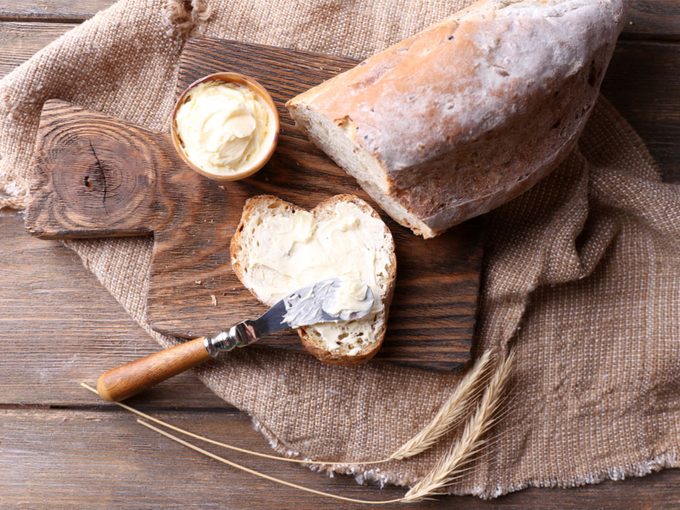The Real Reason Butter Is Making A Comeback
After all of these years of trying to eliminate butter from our diets, it turns out that it might actually be good for you.

Just because butter is less processed, is it really better for you?
Butter makes everything taste better – that’s the kind of thinking that iconic chef Julia Child famously promoted with her cooking. However, fear surrounding butter’s saturated fat content saw it eliminated from most diets over the years as a food spread and cooking fat – though butter is still preferred for baking – until recently. “Today, butter is making a comeback because people appreciate it as a natural, ‘clean’ food compared to margarine,” says Lindy Kennedy, a registered dietitian at Fit Nut Consulting in Calgary, Alta. She explains that margarine is a processed food – vegetable oil is converted into a fat solid, by adding hydrogen in a process known as “hydrogenation.” But the real question is: What are the health benefits of butter?
What are the health benefits of butter?
Butter is made from the cream of whole milk through a churning process that separates out the fat content of the cream. Basic salted butter is made up of about 80 per cent fat, 15 to 17 per cent water and the rest salt, protein, calcium and phosphorous and fat-soluble vitamins A, D and E.
Butter contains the antioxidants vitamin A and vitamin E, as well as selenium. Butter also naturally contains conjugate linoleic acids (CLAs), compounds which have been shown to prevent cancer in animal studies, as well as prevent the hardening of the arteries, which can lead to heart disease. Vancouver registered dietitian Nicole Fetterly also points out that butter contain butyric acid, a short-chain fatty acid with anti-fungal and anti-tumour properties. “In India, clarified butter or ghee is considered a health food for these reasons,” says Fetterly. (If you’re more of a natural butter person, ghee will definitely be right up your alley.)
What about the saturated fat?
Because butter comes from an animal, it contains higher amounts of saturated fat – the bad kind of fat that has been linked to an increased risk of high cholesterol and heart disease. According to Health Canada, one pat of butter (5 mL) contains 34 calories and four grams of fat, more than half of which (2.5 g) is saturated. (The same amount of non-hydrogenated margarine contains the exact same calories and fat, but just a fraction of the saturated fat at 0.5 g.) Fetterly says that research is underway to determine what the long-term health impact of processed margarine is compared to the health benefits of more natural butter.
Aquire more of a nuttier taste? This seed butter will forever change the way you snack.
How much butter should you eat?
Regardless of whether you opt for margarine or butter, both are pure fat, and the rule of thumb is to eat no more than 20-30 per cent of calories from fat – this works out to around 50-75 grams of fat per day. However, of those fats allowed, less than seven per cent of total calories should be saturated fats. Butter usually has seven grams of saturated fat per tablespoon, so keeping intake to less than three teaspoons (or one tablespoon) is ideal. However, you should also be aware of hidden saturated fats in other areas of your diet that may increase your total saturated fat number, and adjust accordingly. This includes foods such as beef and the occasional chocolate chip cookie, says Kennedy.
For greater health benefits of butter, fat should be mono and polyunsaturated, such as the kind you’ll find in vegetable oils, nuts and fish. (Try this butternut squash mac and cheese with butter – it is to die for!) Bottom line? If you enjoy the flavour of butter, use it judiciously – but don’t go overboard.




